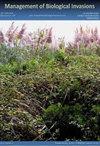Management of the invasive Nuttall’s pondweed (Elodea nuttallii) in Lough Arrow, a Natura 2000 designated lake in Western Ireland
IF 1.2
4区 环境科学与生态学
Q3 BIODIVERSITY CONSERVATION
引用次数: 1
Abstract
A benth ic geotextile was used to trial the management of an invasive aquatic macrophyte Nuttall’s pondweed ( Elodea nuttallii (Planch.) H. St. John, 1920) in Lough Arrow, a premier trout angling lake in the north-west of Ireland, designated as a Natura 2000 site (Special Area of Conservation (Annex I habitat, “Hard oligo-mesotrophic waters with benthic vegetation of Chara spp.”) and Special Protection Area for birdlife). The aim of this study was to manage E. nuttallii , a relatively recent arrival to this lake, while simultaneously promoting rehabilitation of native charophytes. The trial was carried out in Loughbrick bay, one of the lough’s primary boating launch sites, an area determined as highly infested with E. nuttallii . Two experimental areas covering a total of 800 m 2 were treated by covering the invasive weed and substrate with jute textile, a single and double layer respectively. The trial was successful in controlling E. nuttallii for both single (P = 0) and double layer treatments (P = 0.002). The treatments applied resulted in a reduction of the mean percentage cover of the invasive species by > 60% for both treatments. Post-treatment mean percentage cover of E. nuttallii did not exceed 6% for either treatment. Furthermore, the mean percentage cover of indigenous charophyte flora present pre-treatment was not significantly impacted by the application of jute in either the single (P = 0.165) or double treatment (P = 0.353). For biosecurity purposes, the treatment areas were strategically positioned in close proximity to the bays pier and slipway. The treated transects were marked with navigational buoys to provide a corridor for boats entering and exiting the lake, which help to contain the invasive within the Natura 2000 site while reducing the spread risk via this pathway to other sites vulnerable to infestation.爱尔兰西部《自然》2000年指定湖泊阿罗湖入侵纳托尔塘草(Elodea nuttallii)管理
采用底栖土工布对入侵水生大型植物纳特尔塘草(Elodea nuttallii (Planch.))进行管理试验。H. St. John, 1920),位于爱尔兰西北部的鳟鱼垂钓湖,被指定为2000年自然保护区(特殊保护区(附件一栖息地,“具有查拉属底栖植被的硬寡中营养型水域”)和鸟类特别保护区)。本研究的目的是为了管理相对较晚到达该湖的E. nuttallii,同时促进本地蕨类植物的恢复。试验是在拉夫布里克湾进行的,拉夫布里克湾是该湖的主要划船发射场之一,该地区被确定为高度感染了纳塔利伊氏杆菌。采用黄麻织物单层覆盖和双层覆盖的方法,对两个试验区800 m2的入侵杂草和基材进行处理。单层处理(P = 0)和双层处理(P = 0.002)均能有效控制肉芽孢杆菌。两种处理均使入侵物种的平均覆盖率降低了约60%。处理后两种处理的平均覆盖百分比均不超过6%。此外,黄麻单处理(P = 0.165)和双处理(P = 0.353)对原生叶绿植物区系的平均盖度均无显著影响。出于生物安全考虑,处理区被战略性地设置在靠近海湾码头和船台的位置。经过处理的样带用导航浮标进行标记,为进出湖泊的船只提供一条通道,这有助于控制Natura 2000站点内的入侵,同时减少通过这条通道传播到其他易受感染站点的风险。
本文章由计算机程序翻译,如有差异,请以英文原文为准。
求助全文
约1分钟内获得全文
求助全文
来源期刊

Management of Biological Invasions
Agricultural and Biological Sciences-Ecology, Evolution, Behavior and Systematics
CiteScore
3.40
自引率
6.70%
发文量
21
审稿时长
16 weeks
期刊介绍:
Management of Biological Invasions, established in 2010 by Dr. Elias Dana, is an open access, peer-reviewed international journal focusing on applied research in biological invasions in aquatic and terrestrial ecosystems from around the world. This journal is devoted to bridging the gap between scientific research and the use of science in decision-making, regulation and management in the area of invasive species introduction and biodiversity conservation.
Managing biological invasions is a crisis science, with Management of Biological Invasions aiming to provide insights to the issues, to document new forms of detection, measurements and analysis, and to document tangible solutions to this problem.
In addition to original research on applied issues, Management of Biological Invasions publishes technical reports on new management technologies of invasive species and also the proceedings of relevant international meetings. As a platform to encourage informed discussion on matters of national and international importance, we publish viewpoint papers that highlight emerging issues, showcase initiatives, and present opinions of leading researchers.
 求助内容:
求助内容: 应助结果提醒方式:
应助结果提醒方式:


